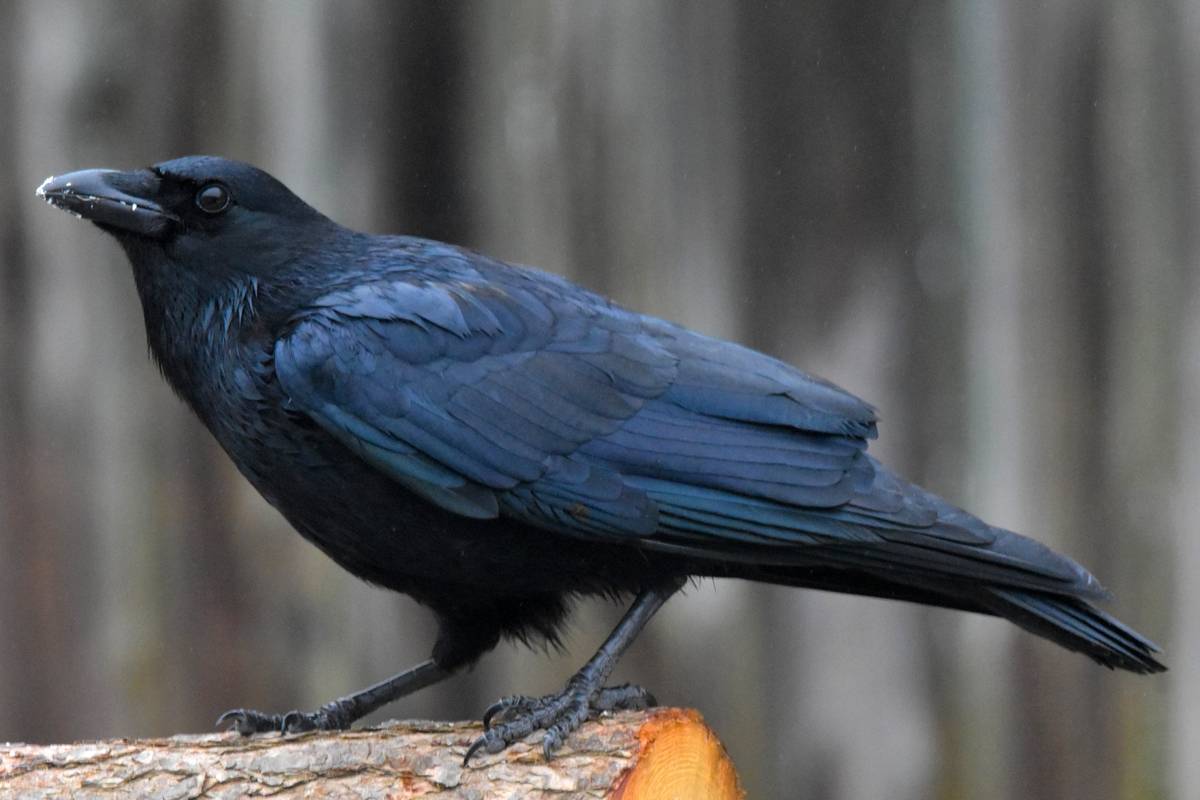10 interesting American crow facts to blow your mind
Meet the amazing American crow- a smart, big bird that thrives all across North America. They’re found from Canada to the U.S. and love living in family gangs. These clever birds team up to build nests, and the mom usually lays four or five eggs each spring or summer. In just five weeks, the little ones go from nest rookies to flying and hunting pros! They are very social who flock usually in the numbers of hundreds. Crows are aggressive in nature and have been seen chasing away hawks and owls.
Scientific name: Corvus brachyrhynchos
Colour: Black
Size: American crow is 40-53 cm long with wingspan size of 85-100 cm
Weight: 320-620 gm
Lifespan: 7-8 years in the wild; 15-18 years in captive
Diet: Omnivores (insects, earthworms, frogs, small snakes, garbage, eggs of younger birds, seeds, grain, fruit)
Class: Aves (warm-blooded vertebrates)
Family: Corvidae
Habitat: American crows like to hang out in open woods and deserted beaches rather than busy town centres. You can often find them in places like treetops, fields, and along the sides of roads. Crows enjoy searching for food in agricultural and grassy areas. They also use nearby wooded areas and forest edges for breeding and resting. American crows do well in suburban neighbourhoods, city parks, and coastal environments.
American crow call sound:
1. American Crows sleep together in large groups during winter

American Crows exhibit a tendency to sleep together in groups, especially during the winter season. Sharing sleeping space with other warm bodies makes it more effective in warding off the winter chill. When roosting together, these birds often position themselves in close proximity, occasionally making physical contact. This close arrangement contributes to the maintenance of a slightly warmer environment around the crow roost.
The act of roosting in groups establishes a “safety in numbers” dynamic that deters potential attacks by predatory birds. Crows may consistently utilize the same winter roost for extended periods. As evidence shown by a survey in New York State that identified roosts in use for over 40 years. The surveyed roosts housed varying bird populations, ranging from a few hundred to a staggering two million individuals. Notably, these sizable roosts were strategically located in regions abundant with food resources.
2. Crows can’t tear apart dead animals themselves
Crows, like many other birds, have beaks that are not well-suited for tearing through tough hides. These hides of animals are often composed of dense connective tissues and fibers. Crows have relatively slender and pointed beaks designed for functions such as probing for insects, pecking at food, or manipulating objects. American crow beaks can’t tear apart dead animal carcasses thus they scavenge on already opened or decaying dead remains.
Their beaks lack special features found in eagles or vultures like strong hooked beaks. These birds of prey are adapted for tearing through the flesh and breaking bones of their prey. In the natural order of things, different animals have evolved specific adaptations for their respective ecological niches and diets. Crows are more likely to feed on smaller, softer prey, or scavenged scraps rather than actively hunting and tearing through tough hides.
3. Crows are happier after using a tool
Not only humans like puzzles and games just for fun birds love it too. Crows, known for their tool-making skills, haven’t been studied in this aspect until now. An experiment was conducted to determine whether they use tools to obtain rewards or not. A wooden block had clear plastic on both sides, and there was meat in between the plastic sheets. The birds could see the meat and had to figure out how to use a tool to get it.
In another setup with everything the same, except the meat was easy to reach in the block, the birds could just grab it with their beak. On average, it took crows 12 seconds to approach the block when they had to use a tool, but 23 seconds when they could grab the meat without using any tools. They get a treat in both situations. In one, they use a tool. Does using a tool make them happier? Yes, we found that they are happier after using a tool to get a treat compared to getting the same treat without using a tool.
4. Crows holds funerals for dead friend

When a crow sees another crow that’s not moving, it makes loud noises to tell its friends. Then, a bunch of crows gather on nearby branches to check out the situation. They make a lot of noise, almost like they’re sad about their friend’s death. They stay quiet for a few minutes, like they’re having a funeral.
If a dangerous animal comes close to the dead crow, the crow’s team up to chase it away. In an experiment, researchers used a fake crow that looked real, and the crows still thought it was their friend. They got upset and made a lot of noise, just like when a real crow dies. Crows probably have these gatherings to figure out what’s risky, like finding out about dangerous places, people, or new predators.
5. People used to eat crow meat in Oklahoma
Dr. T. W. Stallings, a former health superintendent, was the first person to encourage eating crows. He did this because farmers didn’t like crows bothering their crops, and personally, Stallings didn’t like crows either. Initially, he organized “crow banquets” where he disguised the crow meat as quail. He succeeded in making people enjoy eating crows, and even the governor of Oklahoma started a group called the “Statehouse Crow Meat Lovers Association.”
Stallings’ recipe involved rubbing plucked crows with lard to make them less dry. Then, he cooked them in a sealed cast-iron pan with celery, finishing them off with lots of gravy. For Oklahoma farmers, crow meat became a good addition to their meals. In 1947, as part of his “Crow-for-Food movement,” Stallings kept telling reporters that crows were easy to get, full of Vitamin B, and delicious.
6. Crows can remember grudges and pass on too
It has been found that when it comes to reasoning, they are on par with a seven-year-old child. A remarkable fact is that crow’s brains have 1.5 billion neurons, as many as some monkey species, all crammed in there. Crows have unusually big brains which are equal to primates in brain to body proportion. Crows have good memories and can remember if a face is friendly or not because they have big brains with lots of neurons. It can also be seen in the parks when a dog chase away the crows they remember him and greet with loud screams next time he comes.
According to University of Washington, crows can hold grudges and even pass on to other crows. In one research one group was told to wear dangerous masks and scare them. Five years later when researchers wore the same masks again, they were still dive-bombed and screeched by other crows in that area. Not only but also crows passed on the legend of the “dangerous” mask to their flock mates but also to their newborn hatchlings.
7. American crow are very smart species

Crows are really smart birds, even smarter than dolphins. They are good at solving problems, making various sounds, flying well, finding their way around, and adapting to different places. Like pigeons, crows have been used as messengers due to their intelligence. American crows have demonstrated speech-learning capabilities and also possess impressive memories. Scientists have seen crows change their habits to stay safe, like avoiding dangerous areas during migration.
Interestingly, they’ve been spotted remembering the schedule of garbage trucks, so they can quickly snatch a meal as the trucks pass by. Crows have the biggest brains among all birds and can remember human faces. Even though they don’t have hands still they’re clever at using tools. The New Caledonian crow creates a knife to cut leaves and grass. The crows also use a hook-and-line tool to reach food that is difficult to get.
8. They sometimes steal food from other animals
Some people don’t like crows because they eat baby birds and eggs from songbirds nests. Just like hawks help to keep the balance in nature by hunting, crows also have a role too. It’s important to remember that crows and their babies can also be targets for other animals. Scientists at the University of Washington discovered a type of crow that changes its behaviour when stealing food from another crow, depending on whether they are related or not.
The Northwestern crow is calmer when taking food from a family member but gets aggressive when stealing from a crow that isn’t related. This is the first-time researchers have seen this kind of behaviour in any bird. The peanuts cached by squirrel is often spied and stolen by crow when they are not around. Crows amazing memory can even remember colours of thrash can which helps them in stealing and scavenging business.
9. Their life of American crow is quite long

American crows (Corvus brachyrhynchos) are known for their relatively long lifespan compared to many other bird species. But these also depend upon whether the crows live in wild or in captivity. The average lifespan of the American crow is seven to eight years in the wild. That’s just an average, though; young birds die at a higher rate than experienced adults.
Many individuals have been found to live up to 10-15 years. Cornell Lab of Ornithology stated that the oldest recorded wild American crow was 17 years and five months old when it was photographed in Washington state. Captive ones can live much longer, as one in New York lived to be 59 years old. The crow was named Tata. The owners loved this bird, and the last owner reported to a newspaper when you came around him, his energy was very beautiful.
10. American crow is mostly confused with fish crow
American crows (Corvus brachyrhynchos) and fish crows (Corvus ossifragus) are often confused due to their similar appearances. They are generally larger than fish crows. Fish Crows are lighter, weighing around 270-300 grams, while American crows are heavier at 500 grams on average. Despite this weight difference, it’s hard to tell them apart, especially when they’re both around.
Fish crow also have longer wings, longer tail, and a bit shorter leg than American crow. Fish Crows flap their wings faster than American Crows but it’s not a surefire way to tell them apart. But the most reliable way to differentiate between the two crows is their vocal sounds. American crows make a cawing sound, but fish crows have a different, higher-pitched and nasal call that is often described as a “cah” sound.
Read more: 10 amazing American robin facts for you
FAQs
a) How many crow species are there?
There are around 43 types of crows in the world, and they are part of the Corvus group. These birds live in many different places worldwide, such as North America, Europe, Asia, Africa, Australia, and islands in the Pacific.
b) How big is an average american crow?
An American crow is a common bird in many parts of North America. It’s about 16-20 inches long, with half of that length being its tail. The wingspan is 33-39 inches, and it weighs between 11 to 21 ounces, with males usually being bigger than females.
c) How smart is the American Crow?
Scientists say crows are as smart as a seven-year-old kid. Crows, ravens, and other birds like them are the only ones, besides monkeys, that can make tools. Crows can think in abstract ways, solve tricky problems, and make decisions together in groups.


[…] Read more: 10 interesting American crow facts to blow your mind […]